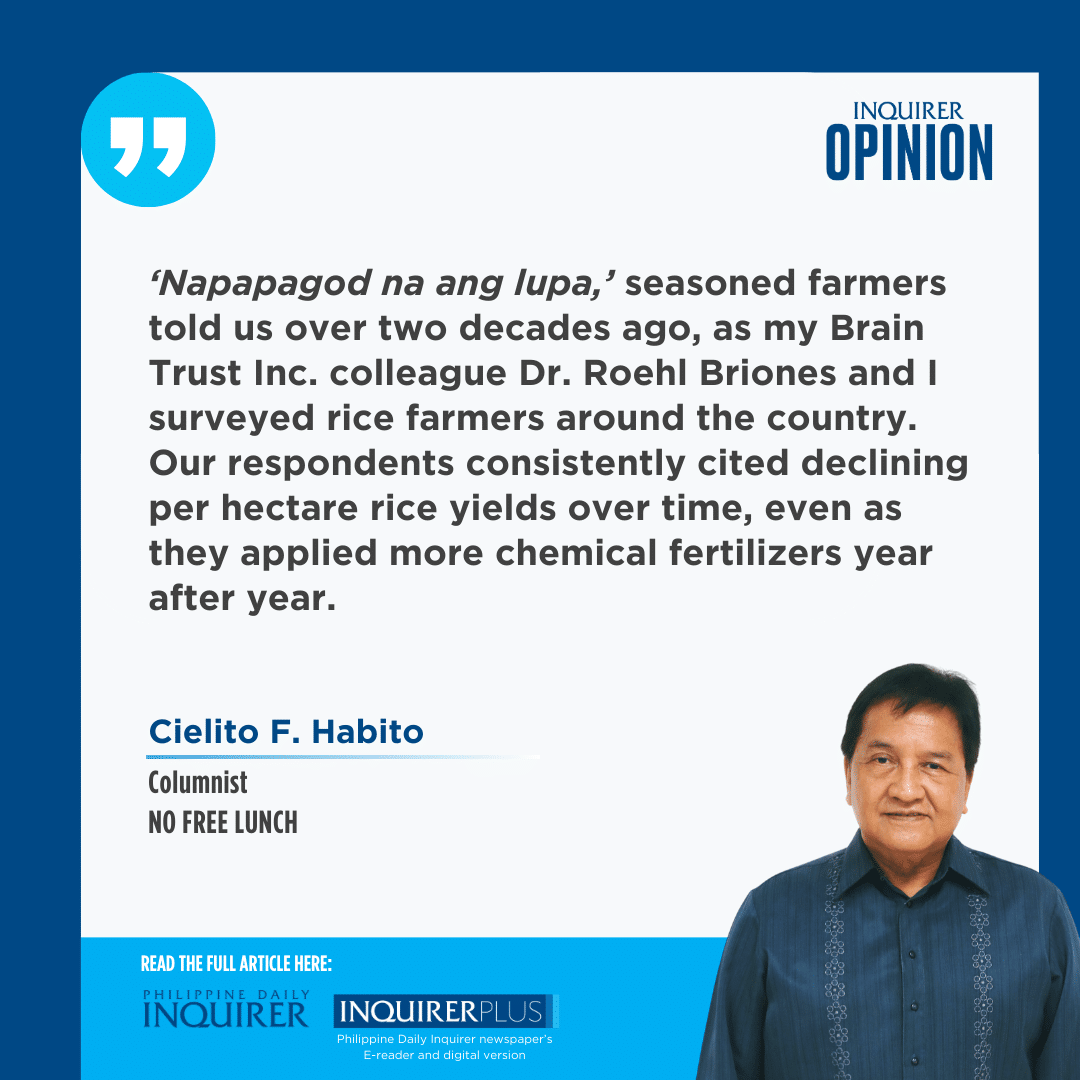Let’s push renewable fertilizers
“Napapagod na ang lupa,” seasoned farmers told us over two decades ago, as my Brain Trust Inc. colleague Dr. Roehl Briones and I surveyed rice farmers around the country. Our respondents consistently cited declining per hectare rice yields over time, even as they applied more chemical fertilizers year after year. Many got less than 50 sacks of palay per hectare, less than half of what was commonly achieved under the Masagana 99 program in the 1970s. It was interesting how they described their soils to be “tired” or “weary” to explain the phenomenon, but it reflects the wisdom of those who had spent the good part of their lives eking out a living from tilling the soil.
Indeed, the only logical explanation seemed to be that the land they were planting to rice year after year had been degraded through time. Scientists point to increased acidity resulting from persistent use of inorganic chemical fertilizers, which are produced from by-products of petroleum processing, including ammonia and sulfur. Chemical fertilizers make soils more acidic because they contain ammonium, which is converted to nitrate in the soil in a chemical process that releases hydrogen ions–and having more of that is what acidity is all about. Higher acidity in turn harms helpful soil microorganisms and reduce their abundance and diversity, promotes growth of harmful microorganisms such as fungi and bacteria, and builds up mineral salts that compact the soil and reduces available water in it. In contrast, organic fertilizers reduce soil acidity over time. And apart from providing soil nutrients like nitrogen, phosphorus, and potassium, they improve soil structure, retain more water, and increase helpful microorganisms in the soil, making the soil healthier and more fertile over time. Mother Nature does her work.
Many years ago, Dr. Mercedes U. Garcia of the University of the Philippines Los Baños National Institute of Molecular Biology and Biotechnology (UPLB-Biotech) developed a natural fertilizer from bacteria taken from the roots of the common talahib. When inoculated into the soil, the bacteria convert nitrogen from the atmosphere into a form plants can readily absorb. The product, called Bio N, improves the plant’s root system, boosts nutrient absorption, provides resistance to pests and diseases, and enhances soil conditions. One kilo of Bio N costing P500 can yield nitrogen equivalent to two bags of urea, the commonly used form of nitrogen fertilizer, which at current prices cost more than P1,500 per bag. Between P500 and P3,000, the choice should be a no-brainer.
It was over 20 years ago when the Department of Agriculture (DA) first adopted Bio N in a 2003 memorandum of agreement with UPLB-Biotech, for the latter to supply Bio N and concentrates to the fertilizer mixers of the DA and local government units. But UPLB-Biotech lacked production capacity, and less than 1 percent of the country’s total biofertilizer needs were served all those years. The breakthrough only came early last year, when UPLB signed a licensing agreement with Agri-Specialist Inc., a Laguna-based agribusiness company founded by distinguished UPLB alumnus Dr. Mario M. Labadan, to commercialize and distribute Bio N nationwide. It took the drastic jump in fertilizer prices triggered by the Russia-Ukraine war, and Labadan’s willingness to make a risky missionary investment, to finally bridge, in the case of Bio N, the all-too-common divide between research innovation and commercialization. Agri Specialist Inc. invested in state-of-the-art equipment to permit Bio N production at a scale that could provide for up to all 7.2 million hectares of rice and corn lands in the country.
The UPLB science community led by National Scientist Dr. Emil Q. Javier brokered that match, but also crucial is government buy-in by pushing for much wider use of this homegrown “renewable fertilizer” under its Balanced Fertilization Strategy (BFS). The BFS provides for balancing the use of inorganic fertilizers with organic and bio fertilizers to reduce costs, rejuvenate degraded soils, and minimize vulnerability to fertilizer supply and price volatilities that the Russia-Ukraine war had heightened. It finds a parallel in government’s balanced energy mix approach under its long-term energy plan for 2023-2050, wherein renewable energy sources would provide for energy security, apart from cleaner energy. Scaling up adoption of Bio N use would also be in keeping with the Tatak Pinoy Act (Republic Act No. 11981) that mandates government to favor innovative Filipino products and services in their procurement.
I’d like to see the DA put its money where its mouth is on BFS by fostering much wider use of renewable fertilizers like Bio N, which, by strengthening our fertilizer security, enhances our long term food security as well.
————–
cielito.habito@gmail.com





















